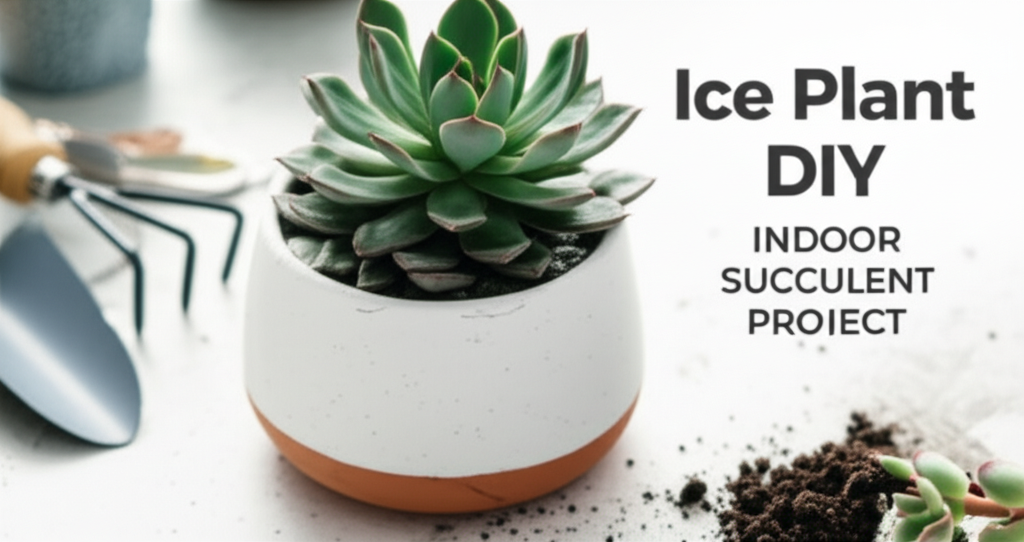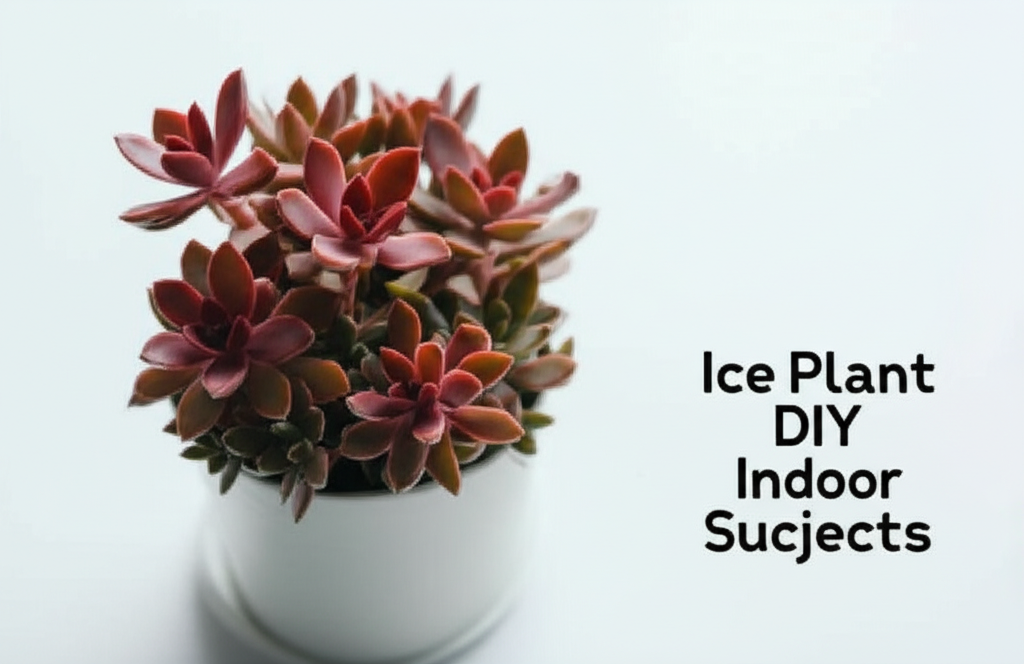Introduction to Ice Plant Succulents: A Cool Addition to Your Home
Ice plants, scientifically known as Mesembryanthemum and Delosperma, are a fascinating group of succulents prized for their unique, jewel-like epidermal cells. These specialized cells, often called “blisters” or “papillae,” reflect light, giving the plant a shimmering, dewy appearance reminiscent of ice crystals. This captivating aesthetic makes them a popular choice for both indoor and outdoor gardening. While many ice plants are native to arid regions and thrive in full sun, several varieties are exceptionally well-suited for indoor cultivation, bringing a touch of low-maintenance, sparkling beauty to any home environment.
This article will delve into the world of ice plant succulents, exploring their distinct characteristics and providing you with a comprehensive guide to embarking on exciting DIY indoor gardening projects. From understanding their basic needs to creating visually stunning displays, we’ll cover everything you need to know to successfully cultivate these delightful plants within your living space.
Understanding Ice Plant Succulents: Key Characteristics and Care Requirements

Before diving into DIY projects, it’s crucial to grasp the fundamental needs of ice plant succulents. Their unique morphology dictates their care, and by understanding these principles, you can ensure their longevity and vibrant appearance.
What Makes Them “Ice” Plants?
The defining feature of ice plants is the presence of specialized, water-filled epidermal cells. These cells serve several purposes:
- Water Storage: They help the plant retain moisture in arid environments.
- Light Reflection: They scatter sunlight, protecting the plant from intense solar radiation and contributing to their shimmering appearance.
- Temperature Regulation: They can help buffer against extreme temperature fluctuations.
Essential Care Requirements for Indoor Ice Plants
While generally low-maintenance, ice plants do have specific needs to thrive indoors:
Light Needs:
Most ice plant varieties require bright, indirect sunlight. A south-facing or east-facing window is typically ideal. If natural light is insufficient, consider using grow lights. Insufficient light can lead to leggy growth and a duller appearance.
Watering:
Like most succulents, ice plants are susceptible to overwatering. Allow the soil to dry out completely between waterings. Water thoroughly, ensuring excess water drains from the pot. During winter months, reduce watering frequency as the plant enters a period of dormancy.
Soil:
A well-draining soil mix is paramount. A cactus or succulent potting mix is recommended. You can also create your own by combining potting soil with perlite or pumice in a 2:1 ratio.
Temperature:
Ice plants prefer average room temperatures, typically between 65-75°F (18-24°C). They can tolerate cooler temperatures, but protect them from frost.
Potting:
Choose pots with drainage holes to prevent waterlogging. Terracotta pots are excellent as they allow the soil to breathe and dry out more quickly.
Popular Ice Plant Varieties for Indoor Gardens
While there are many species, some are more commonly found and adaptable for indoor settings:
- Delosperma cooperi (Cooper’s Ice Plant): Known for its vibrant magenta-pink flowers and trailing habit.
- Mesembryanthemum crystallinum (Common Ice Plant): Features attractive, silvery leaves and small, white or pink flowers.
- Delosperma floribundum: Offers abundant bright purple flowers and a compact, mounding growth habit.
Key Facts and Comparison: Ice Plant Succulents vs. Other Popular Succulents
To further appreciate the unique qualities of ice plants, let’s compare them to some other common indoor succulents.
| Feature | Ice Plant (e.g., Delosperma) | Echeveria | Haworthia | Sedum |
|---|---|---|---|---|
| Epidermal Cells | Present, prominent (blisters/papillae) | Absent | Present, often translucent (‘windows’) | Absent |
| Water Storage | Primary in epidermal cells and leaves | Primarily in fleshy leaves | Primarily in fleshy leaves and roots | Primarily in fleshy leaves and stems |
| Light Preference | Bright, indirect sunlight | Bright, direct to indirect sunlight | Bright, indirect sunlight | Bright, direct to indirect sunlight |
| Dormancy | Can have a slight winter dormancy | Less pronounced dormancy | Less pronounced dormancy | Can have a slight winter dormancy |
| Flowering (Indoors) | Possible, often vibrant | Possible, usually less showy | Less common indoors, often small spikes | Possible, often small star-shaped flowers |
| Overall Appearance | Shimmering, dewy, often trailing or mounding | Rosette-shaped, fleshy leaves | Zebra-striped or textured, often small and compact | Varied, often fleshy leaves or trailing stems |
DIY Indoor Gardening Projects Featuring Ice Plant Succulents
Now, let’s get creative! Ice plant succulents are incredibly versatile for DIY projects, offering both aesthetic appeal and ease of care.
Project 1: The “Frozen Oasis” Terrarium
This project focuses on creating a miniature desert landscape where the ice plant’s unique textures can shine.
Materials Needed:
- A clear glass terrarium or bowl with a wide opening
- Well-draining succulent or cactus mix
- Activated charcoal
- Decorative gravel or small stones
- Sand (optional, for top dressing)
- Small ice plant succulent(s)
- Moss (preserved or dried, for accent)
- Small decorative elements (e.g., tiny figurines, polished rocks)
Steps:
- Drainage Layer: Place a layer of activated charcoal at the bottom of the terrarium. This helps filter water and prevent odors.
- Substrate: Add a layer of well-draining succulent mix on top of the charcoal. The depth will depend on the size of your terrarium and the root ball of your plants.
- Planting: Gently remove the ice plant from its nursery pot. Loosen any tightly bound roots. Dig a small hole in the soil and place the succulent in it, ensuring the base of the plant is at soil level.
- Arrangement: Add more succulents or other compatible low-water plants if desired. Arrange them artistically.
- Decoration: Cover the exposed soil with decorative gravel or sand. Add preserved moss and small decorative elements to create your desired miniature scene.
- Initial Watering: Water lightly around the base of the plants. Avoid overwatering, especially in a closed or semi-closed terrarium.
- Placement: Position the terrarium in a location that receives bright, indirect sunlight.
Project 2: The Hanging “Dewdrop” Basket
Embrace the trailing nature of some ice plant varieties by creating a captivating hanging basket.
Materials Needed:
- A hanging basket (wire or coco liner)
- Coco liner or sphagnum moss (for lining)
- Well-draining succulent or cactus mix
- Trailing ice plant succulent(s) (e.g., Delosperma cooperi)
- Slow-release succulent fertilizer
- Wire cutters (if needed for wire baskets)
- S-hook or chain for hanging
Steps:
- Line the Basket: If using a wire basket, line it with a coco liner or a layer of sphagnum moss. This prevents the soil from falling through the wire mesh.
- Prepare the Soil: Mix a good amount of perlite or pumice into your succulent potting mix to ensure excellent drainage.
- Planting: Fill the basket about two-thirds full with the prepared soil mix. Gently remove your trailing ice plant from its pot, loosen the roots, and place it in the center of the basket.
- Fill and Arrange: Add more soil around the plant, leaving about an inch of space at the top for watering. You can add multiple plants to create a fuller effect. Position them so that their trailing stems cascade over the sides of the basket.
- Fertilize: Mix a small amount of slow-release succulent fertilizer into the soil according to package directions.
- Initial Watering: Water thoroughly until water drains from the bottom.
- Hanging: Attach the hanging mechanism (S-hook or chain) and hang the basket in a location with bright, indirect sunlight.
Project 3: The “Crystal Cluster” Pebble Pot
This project is about showcasing the unique texture and form of ice plants in a minimalist, striking arrangement.
Materials Needed:
- A shallow, wide pot (terracotta or ceramic with drainage holes)
- Well-draining succulent or cactus mix
- Coarse gravel or pebbles (for soil amendment and top dressing)
- Ice plant succulents with interesting forms
- Optional: small decorative stones or crystals
Steps:
- Prepare the Soil: Mix a generous amount of coarse gravel into your succulent potting mix (e.g., 1:1 ratio). This creates a very porous and fast-draining environment, mimicking rocky desert conditions.
- Potting: Fill the pot with the gravelly soil mix.
- Arrangement: Place your ice plant succulents in the pot, grouping them closely together to create a “cluster” effect. Consider the natural growth habits of each plant.
- Top Dressing: Cover the exposed soil surface with a layer of contrasting pebbles or gravel. This not only looks attractive but also helps keep the plant crowns dry.
- Optional Embellishments: Add a few small decorative stones or polished crystals strategically placed among the plants for an extra touch of sparkle.
- Watering: Water sparingly after planting. Allow the soil to dry out completely before the next watering.
- Placement: Place in a spot that receives plenty of bright, indirect light.
Maintenance and Troubleshooting for Your Ice Plant Projects
Even with the best intentions, sometimes plants need a little extra attention. Here’s how to keep your ice plant projects thriving:
Common Issues and Solutions
| Problem | Cause | Solution |
|---|---|---|
| Mushy, Yellowing Leaves | Overwatering, poor drainage | Allow soil to dry completely. Check drainage holes. Repot in a well-draining mix if necessary. Reduce watering frequency. |
| Shriveled, Dry Leaves | Underwatering, too much direct sun, low humidity | Water thoroughly and allow to drain. Move to a location with bright, indirect light. Mist lightly if humidity is very low (rarely needed for ice plants). |
| Leggy Growth (Stretched Stems) | Insufficient light | Move to a brighter location. Consider using grow lights. You can prune leggy stems, and they may root easily. |
| No Flowers | Insufficient light, plant is too young, improper dormancy | Ensure adequate bright light. Be patient; flowering can take time. Reduce watering slightly in winter to encourage flowering in spring/summer. |
| Pests (e.g., Mealybugs, Spider Mites) | Stress, poor air circulation | Isolate the affected plant. Wipe pests off with a cotton swab dipped in rubbing alcohol. For severe infestations, use an insecticidal soap or neem oil. |
Seasonal Care Adjustments
Spring/Summer: This is the active growing season for most ice plants. Water more frequently as needed (when soil is dry) and ensure they receive ample bright light. You may see flowering during this period.
Autumn/Winter: As temperatures cool, ice plants enter a period of reduced growth. Reduce watering significantly. Ensure they are still receiving adequate light, though they can tolerate slightly less than in summer. Protect from freezing temperatures.
Conclusion: Bringing the Sparkle Indoors
Ice plant succulents offer a unique blend of fascinating morphology, vibrant potential, and relatively easy care, making them ideal candidates for DIY indoor gardening projects. Whether you choose to create a miniature desert in a terrarium, let their trailing beauty cascade from a hanging basket, or showcase their crystalline forms in a pebble pot, these projects are rewarding and accessible for all skill levels.
By understanding their specific needs for light, water, and soil, and by implementing the DIY project ideas outlined above, you can successfully cultivate these sparkling succulents. Their ability to thrive with minimal fuss and their captivating visual appeal will undoubtedly add a touch of cool, refreshing elegance to your indoor garden, bringing the wonder of nature’s ingenuity right into your home. So, gather your materials, unleash your creativity, and enjoy the process of bringing these delightful “ice” plants to life indoors.


